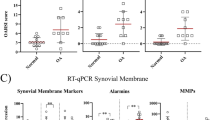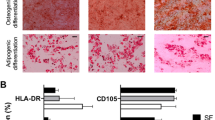Abstract
Purpose
The use of passaged chondrocytes is the current standard for autologous chondrocyte implantation (ACI). De-differentiation due to amplification and donor site morbidity are known drawbacks highlighting the need for alternative cell sources.
Methods
Via clinically validated flow cytometry analysis, we compared the expression of human stem cell and cartilage markers (collagen type 2 (Col2), aggrecan (ACAN), CD44) of chondrocytes (CHDR), passaged chondrocytes for ACI (CellGenix™), bone marrow derived mesenchymal stem cells (BMSC), and synovial derived stem cells (SDSC).
Results
Primary, human BMSC and SDSC revealed similar adipogenic, osteogenic, and chondrogenic differentiation potential and stem cell marker expression. However, the expression of the chondrogenic markers Col2 and ACAN was statistically significant higher in SDSC. CHDR and SDSC expressed ACAN and CD44 equally, but Col2 was expressed more strongly on the SDSC surface. The marker expression of SDSC from osteoarthritic joints (Kellgren-Lawrence score ≥3) versus normal knees (Kellgren-Lawrence score ≤2) did not differ. Similarly, there was no difference between temporarily frozen and fresh SDSC. Col2 and ACAN surface expression declined with further passaging, whereas CD44 remained unchanged. We observed the same effect after reducing the serum content. When comparing CHDR for ACI with SDSC of the same passage (P2/3), both Col2 and ACAN, correlating with clinical outcome, were expressed higher in SDSC.
Conclusions
In summary, SDSC demonstrated high differentiation potential and a stable chondrogenic phenotype. They might therefore be better suitable for ACI than BMSC or passaged CHDR.




Similar content being viewed by others
References
Jones DG, Peterson L (2006) Autologous chondrocyte implantation. J Bone Joint Surg Am 88(11):2502–2520
Salzmann GM, Erdle B, Porichis S, Uhl M, Ghanem N, Schmal H, Kubosch D, Sudkamp NP, Niemeyer P (2014) Long-term T2 and qualitative MRI morphology after first-generation knee autologous chondrocyte implantation: cartilage ultrastructure is not correlated to clinical or qualitative MRI outcome. Am J Sports Med 42(8):1832–1840. doi:10.1177/0363546514536682
Niemeyer P, Porichis S, Steinwachs M, Erggelet C, Kreuz PC, Schmal H, Uhl M, Ghanem N, Sudkamp NP, Salzmann G (2014) Long-term outcomes after first-generation autologous chondrocyte implantation for cartilage defects of the knee. Am J Sports Med 42(1):150–157. doi:10.1177/0363546513506593
Kubosch EJ, Heidt E, Bernstein A, Bottiger K, Schmal H (2016) The trans-well coculture of human synovial mesenchymal stem cells with chondrocytes leads to self-organization, chondrogenic differentiation, and secretion of TGFbeta. Stem Cell Res Ther 7(1):64. doi:10.1186/s13287-016-0322-3
Jones BA, Pei M (2012) Synovium-derived stem cells: a tissue-specific stem cell for cartilage engineering and regeneration. Tissue Eng B Rev 18(4):301–311. doi:10.1089/ten.TEB.2012.0002
Pestka JM, Schmal H, Salzmann G, Hecky J, Sudkamp NP, Niemeyer P (2011) In vitro cell quality of articular chondrocytes assigned for autologous implantation in dependence of specific patient characteristics. Arch Orthop Trauma Surg 131(6):779–789. doi:10.1007/s00402-010-1219-8
Niemeyer P, Pestka JM, Salzmann GM, Sudkamp NP, Schmal H (2012) Influence of cell quality on clinical outcome after autologous chondrocyte implantation. Am J Sports Med 40(3):556–561. doi:10.1177/0363546511428879
Kellgren JH, Lawrence JS (1957) Radiological assessment of osteo-arthrosis. Ann Rheum Dis 16(4):494–502
Huebner EJ, Torio Padron N, Kubosch D, Finkenzeller G, Suedkamp NP, Niemeyer P (2015) Sequential differentiation of human bone marrow stromal cells for bone regeneration. Tissue Eng Regen Med 12(5). doi:10.1007/s13770-014-9945-6
Dominici M, Le Blanc K, Mueller I, Slaper-Cortenbach I, Marini F, Krause D, Deans R, Keating A, Prockop D, Horwitz E (2006) Minimal criteria for defining multipotent mesenchymal stromal cells. The international society for cellular therapy position statement. Cytotherapy 8(4):315–317. doi:10.1080/14653240600855905
Pittenger MF, Mackay AM, Beck SC, Jaiswal RK, Douglas R, Mosca JD, Moorman MA, Simonetti DW, Craig S, Marshak DR (1999) Multilineage potential of adult human mesenchymal stem cells. Science 284(5411):143–147
Niemeyer P, Pestka JM, Kreuz PC, Salzmann GM, Kostler W, Sudkamp NP, Steinwachs M (2010) Standardized cartilage biopsies from the intercondylar notch for autologous chondrocyte implantation (ACI). Knee Surg Sports Traumatol Arthrosc 18(8):1122–1127. doi:10.1007/s00167-009-1033-4
Hauselmann HJ, Fernandes RJ, Mok SS, Schmid TM, Block JA, Aydelotte MB, Kuettner KE, Thonar EJ (1994) Phenotypic stability of bovine articular chondrocytes after long-term culture in alginate beads. J Cell Sci 107(Pt 1):17–27
Shirasawa S, Sekiya I, Sakaguchi Y, Yagishita K, Ichinose S, Muneta T (2006) In vitro chondrogenesis of human synovium-derived mesenchymal stem cells: optimal condition and comparison with bone marrow-derived cells. J Cell Biochem 97(1):84–97. doi:10.1002/jcb.20546
Qi J, Chen A, You H, Li K, Zhang D, Guo F (2011) Proliferation and chondrogenic differentiation of CD105-positive enriched rat synovium-derived mesenchymal stem cells in three-dimensional porous scaffolds. Biomed Mater 6(1):015006. doi:10.1088/1748-6041/6/1/015006
Nagase T, Muneta T, Ju YJ, Hara K, Morito T, Koga H, Nimura A, Mochizuki T, Sekiya I (2008) Analysis of the chondrogenic potential of human synovial stem cells according to harvest site and culture parameters in knees with medial compartment osteoarthritis. Arthritis Rheum 58(5):1389–1398. doi:10.1002/art.23418
Segawa Y, Muneta T, Makino H, Nimura A, Mochizuki T, Ju YJ, Ezura Y, Umezawa A, Sekiya I (2009) Mesenchymal stem cells derived from synovium, meniscus, anterior cruciate ligament, and articular chondrocytes share similar gene expression profiles. J Orthop Res 27(4):435–441. doi:10.1002/jor.20786
Albrecht C, Schlegel W, Eckl P, Jagersberger T, Sadeghi K, Berger A, Vecsei V, Marlovits S (2009) Alterations in CD44 isoforms and HAS expression in human articular chondrocytes during the de- and re-differentiation processes. Int J Mol Med 23(2):253–259
Peterson L, Brittberg M, Kiviranta I, Akerlund EL, Lindahl A (2002) Autologous chondrocyte transplantation. Biomechanics and long-term durability. Am J Sports Med 30(1):2–12
Tan AR, Alegre-Aguaron E, O’Connell GD, VandenBerg CD, Aaron RK, Vunjak-Novakovic G, Chloe Bulinski J, Ateshian GA, Hung CT (2015) Passage-dependent relationship between mesenchymal stem cell mobilization and chondrogenic potential. Osteoarthr Cartil 23(2):319–327. doi:10.1016/j.joca.2014.10.001
Campbell DD, Pei M (2012) Surface markers for chondrogenic determination: a highlight of synovium-derived stem cells. Cells 1(4):1107–1120. doi:10.3390/cells1041107
Pei M, He F, Li J, Tidwell JE, Jones AC, McDonough EB (2013) Repair of large animal partial-thickness cartilage defects through intraarticular injection of matrix-rejuvenated synovium-derived stem cells. Tissue Eng A 19(9–10):1144–1154. doi:10.1089/ten.TEA.2012.0351
Mak J, Jablonski CL, Leonard CA, Dunn JF, Raharjo E, Matyas JR, Biernaskie J, Krawetz RJ (2016) Intra-articular injection of synovial mesenchymal stem cells improves cartilage repair in a mouse injury model. Sci Rep 6:23076. doi:10.1038/srep23076
Kondo S, Muneta T, Nakagawa Y, Koga H, Watanabe T, Tsuji K, Sotome S, Okawa A, Kiuchi S, Ono H, Mizuno M, Sekiya I (2016) Transplantation of autologous synovial mesenchymal stem cells promotes meniscus regeneration in aged primates. J Orthop Res. doi:10.1002/jor.23211
Sekiya I, Muneta T, Horie M, Koga H (2015) Arthroscopic transplantation of synovial stem cells improves clinical outcomes in knees with cartilage defects. Clin Orthop Relat Res 473(7):2316–2326. doi:10.1007/s11999-015-4324-8
Acknowledgements
The study was funded by the Research Commission of the Albert-Ludwigs University Medical Center Freiburg and the Department of Education and Research Germany (01EC1001D).
Author information
Authors and Affiliations
Corresponding author
Ethics declarations
Conflict of interest
The authors declare that they have no competing interests. PN has received reimbursement for attending conferences and fees for educational presentations by the companies Co.don (Teltow, Germany), Aesculap (Tuttlingen, Germany), Arthrex (Naples, USA), Tigenix (Leuven, Belgium). Furthermore Research funding has been provided by the companies Co.don and Tigenix. None of the above mentioned was in direct context to the present study.
Rights and permissions
About this article
Cite this article
Kubosch, E.J., Heidt, E., Niemeyer, P. et al. In-vitro chondrogenic potential of synovial stem cells and chondrocytes allocated for autologous chondrocyte implantation — a comparison. International Orthopaedics (SICOT) 41, 991–998 (2017). https://doi.org/10.1007/s00264-017-3400-y
Received:
Accepted:
Published:
Issue Date:
DOI: https://doi.org/10.1007/s00264-017-3400-y




